Toll Free: 1-866-508-6394
OR Contact Us
OR Contact Us
Shop by Category
| Text By Bill Holland Photos courtesy of ATI Posted on December 16, 2013 on dragracermag.com |
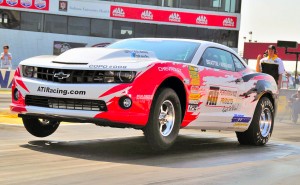 Fast forward four-plus decades and the powers that be at General Motors thought a good way to gain some motorsports cred for its newly resurrected Fifth Generation Camaro was to bring back the COPO program. With a prototype that debuted at the 2011 SEMA Show chumming the waters, a sizeable list of interested buyers was accumulated in Detroit. 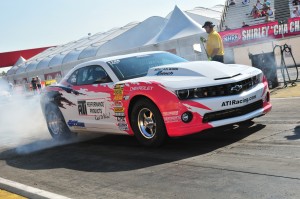 The combination of solid GM chassis design plus several Beattie modifications has created a COPO that leaves hard and tracks straight. One of those to put his name on the list was J.C. Beattie Jr., a second-generation racer whose family operates the highly successful ATI Performance Products, Inc. in Baltimore. J.C. is no stranger to factory hot rods as the proud owner of an ’09 Dodge Challenger Drag Pak that ranks among the strongest in its class. J.C. stored the thought of owning one of the rare creations in the back of his mind until the fateful phone call came to let him know that he was one of the 69 racers selected to purchase a COPO. J.C.’s racing pedigree notwithstanding, the fact that ATI worked closely with Chevrolet to develop the driveline package for the COPO Camaro likely had some influence on the selection committee. Chevrolet initially offered the COPO Camaro with three engine packages: 427-cid, normally aspirated LS7-based motor, plus 5.3L supercharged LSX-based power plants equipped with either a 2.9L Whipple huffer, and what J.C. has, one with a 4L Whipple blower, carrying an NHRA-factored rating of 568 hp but is likely twice as powerful in racing trim. 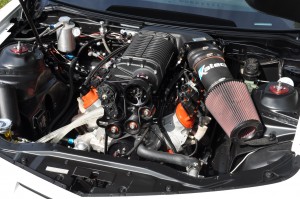 The engine and surroundings look deceptively stock. The multi-dimensional Katech crew built the LSX-based engine, which is producing more than 1,000 hp. Engines were individually assembled at the GM plant in Wixom, Michigan, and owners were offered the opportunity to participate in the build. Examination of the build sheet confirms that a plethora of aftermarket components were employed to boost the COPO’s performance. The supercharged engine in J.C.’s car featured a 4.065-inch bore LSX cast iron block, Callies forged 4340 crank (3.150-inch stroke) and Callies 4340 H-beam rods with Mahle 10:1 domed pistons, a Comp Cams hydraulic roller cam (theoretical lift of .630 inch on both intake and exhaust), Chevrolet Performance ceramic ball hydraulic roller lifters and 3/8-inch-diameter LS7 pushrods. Breathing is courtesy of CNC-machined LS7-based aluminum heads with a 275cc nominal intake port volume. An ATI Super Damper was GM’s choice in the balancer department. 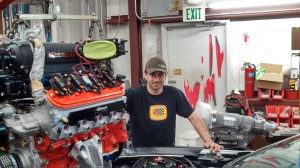 J. C. Beattie Jr. has every right to smile. A Katech engine, #8 COPO and a bullet-proof ATI transmission in the background—life doesn’t get much better. A 4-inch o.d. 6061 aluminum driveshaft with 1350 series U-joints links the “Glide to a 9” rear with a Strange center section and 4.29 gears. The four-bar (with adjustable top links) rear suspension includes double-adjustable Strange coil-overs, an adjustable panhard bar and an anti-roll bar. Nine-inch-wide rear tires and Bogart wheels complete the package. 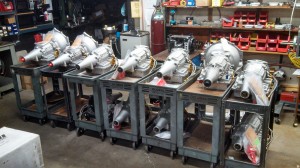 ATI Power Glide transmissions headed for a workout on the dyno before all but one are shipped to GM for the COPO Camaro Program. The ATI Camaro was delivered on Aug. 8, 2012 (carrying COPO serial number 008), and was quickly readied for its debut at the NHRA U.S. Nationals. Still occupied with the Dodge, Beattie turned the driving chores over to his pal, Marty Rinehart Jr., who pushed the SSA/A entry to an 8.66, 158-mph clocking to lead all of the COPO Camaros in the class at Indy. 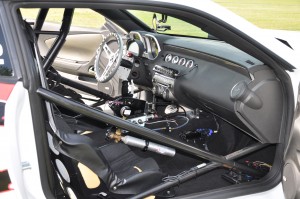 The interior is a mixture of race and factory Camaro. Note the airbag-equipped steering wheel has been “bagged” in favor of a much lighter race unit. COPOs came from the factory with a 4130 chrome-moly roll cage NHRA-certified to 8.50. J.C. plans on putting the car on a diet in order to run the SS/AAA category. Anticipating E.T.s in the 8.30s, the cage has been updated to meet the criteria for door cars running as quick as 7.50. Beattie has also equipped the Camaro with a parachute as an added safety measure. 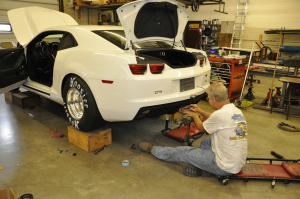 Maryland chassis builder Ken Keir took care of several important upgrades, including installing the 7.50 roll cage, wheelie bars and a parachute. The driveline has been enhanced with a full complement of Mark Williams Enterprises products, including a 7075 aluminum driveshaft that meets SFI specs 43.1, ultimate axles and an aluminum through bolt Pro Stock center section.Upcoming is a Racepak Smart-Wire setup (where a solid state relay system will run all the car’s functions) replacing the factory loom, which offers significant weight savings. And it will also integrate with the V300SD for all the data acquisition. Other impending electronics modifications include exchanging the elaborate Delco MEFI ECU for a more racing friendly setup from AEM. The new AEM Infinity is the same platform as his Challenger uses, so going back and forth between cars will be much easier. Engine work has been entrusted to Katech. The Clinton, Michigan-based firm is best known for its oval track and road racing exploits, but Beattie sees them as being ideally positioned to enhance the reliability and consistency of the LS7 engine, essential traits for Stock and Super Stock racing. Katech has also benefited from its involvement with the all-conquering GM Corvette Racing team, which has extensive success with LS engines. Beattie has removed the original motor and put it into storage. A major focus on the new engine has been on top-end development, with considerable time spent on Katech’s Spintron relative to valvetrain stability and camshaft design to push the limits of peak rpm while maintaining a safe package. With this engine also benefiting from a pair of six-bolt GM LSX-style heads to help with combustion chamber sealing, the new motor should be ready for a full season of racing. When asked to compare the on-track characteristics of the two factory hot rods in his stable, J.C. said, “The COPO Camaro runs in Super Stock and is about a second quicker and much faster than the Challenger. The engine is putting out 1,100-plus-hp and the acceleration is great. It’s also got a trans brake, so launches are different. And because the car is so powerful you really have to respect it. You have to learn how the car reacts, and keep it under control.” Recent test outings have produced elapsed times in the 8.5 and 8.6 range, under less-than-ideal track and weather conditions. There’s ample room to ramp up performance in the future. With renewed interest in drag racing shown by the factories and various racing associations promoting Chevy vs. Dodge vs. Ford competition, today’s COPO Camaro will surely be in the thick of things. Add J.C. Beattie Jr.’s drive and competitive spirit to the mix and you have some serious potential here. His dad won a Wally with his famed Black Magic Funny Car. J.C. would like to do the same with his COPO Camaro. |